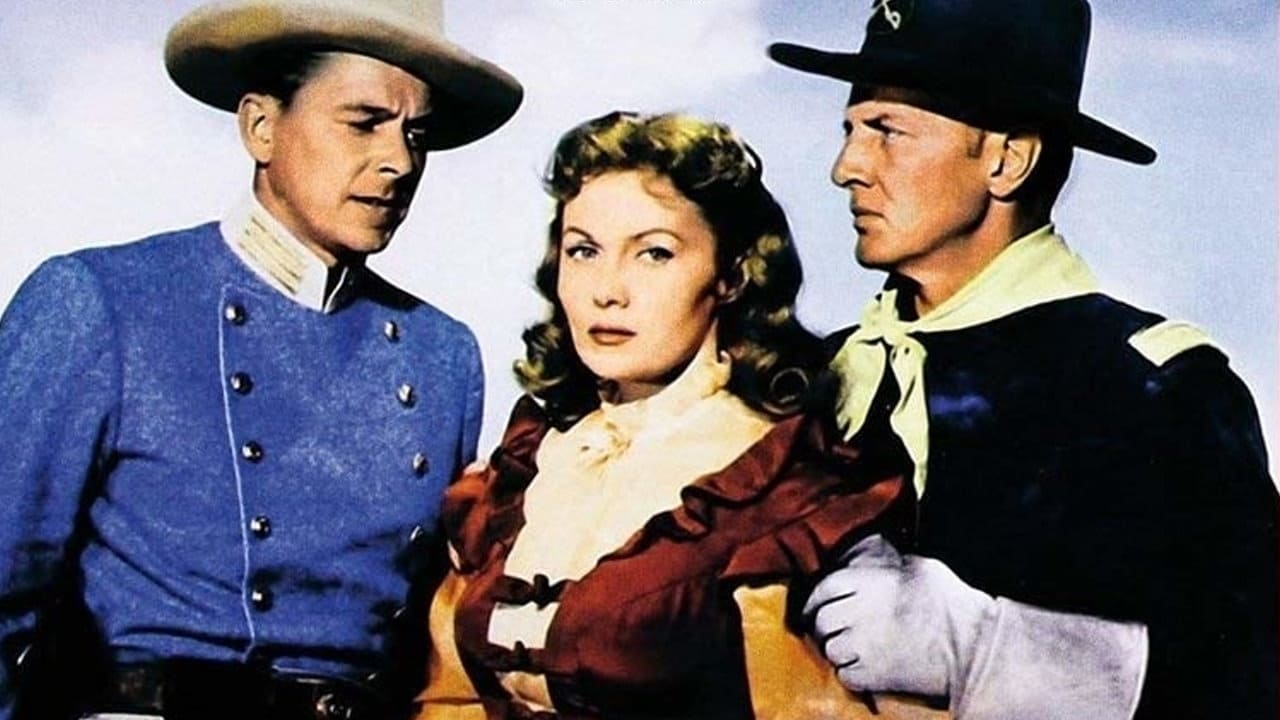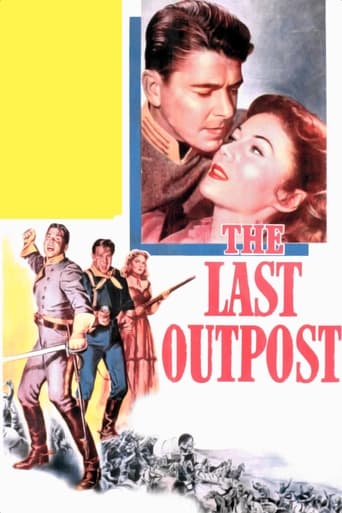

This film made me go back in time. I saw it when I was 9 years old and loved it so much I kept annoying people by trying to tell them the film story. Today, I rate it as an average western, colorful, and where everything happens very fast contributing to its entertainment value. Ronald Reagan is Confederate Captain Vance Britten who has a brother who is an officer in the Union. Reagan ends up changing colors of uniform in order to avoid a great Indian attack and meets his brother and his old sweetheart, the beautiful Rhonda Fleming in most awkward circumstances. Noah Beery Jr. as always is his lovable sidekick Sgt. Calhoun. If ever an actor was stereotyped in a role it was Beery Jr. The best of the film is Lloyd Corrigan as Mr. Betancourt, the "expediter". His bureaucracy and pomposity are a fantastic caricature of what we see in our everyday life.
... View MoreThis isn't one of those "researched" cavalry Westerns. This is just a fun fest. It's everything that is cool in a film. It is Raiders of the Lost Ark, only it's an old fashioned Western.First, we have the "cool" Robin Hood style hero, this time in the guise of a Confederate officer, along with his cool merry men, particularly the affable Noah Beery.Then we have his old sweetheart married to a sneaky bad guy.Then we have the older brother as a more officious officer on the Union side. Naturally, they clash.Then we have the noble native American chiefs. This is middle of the road in treatment of the Indian. The Indians are treated with great dignity and respect, and like most old Hollywood Westerns, they are never bad, but misled by evil white men.However, as many note, this is almost like two different movies from the first two thirds to the last third. In the end, although the evil guys are a pair of white men, the Indians get the brunt of the assault.The other major problem is that the main bad guy is killed almost immediately, and we're left without a villain, until a towns-person takes the role, but it looks like an afterthought, as though there was a contract dispute with an actor somewhere. It is a novel idea, but not dramatic, and certainly not Hollywood.However, this is an Indiana Jones style adventure, filled with humor and pathos along the way. We know a few good men will die. We aren't sure who, but there are clues that give us good ideas.This isn't a "look for reality" movie, nor does it pretend to be. It is a barroom brawl fun-house film, made to be cool. And it succeeds.
... View MoreRonald Reagan's first starring western occurred in 1951 when he did this horse opera for the Pine-Thomas Paramount B picture unit. Reagan was always a good rider and would have loved to do more westerns in his career. But according to the Citadel Film series book on The Films of Ronald Reagan the real clincher for him okaying the Pine-Thomas deal was a chance to ride his own horse in the film. So Reagan's horse which was named Tarbaby got some screen immortality.The Last Outpost casts Reagan and Bruce Bennett who are brothers and who have split their loyalties during the Civil War. Fate has brought them together in the west with Bennett taking command of a Federal outpost in Arizona territory to deal with a band of pesky Confederate raiders. Little does Bennett know that Reagan is commanding those raiders and little does Reagan know that the girl he left behind played by Rhonda Fleming is out west and unhappily married to trading post owner John Ridgely.Ridgely gets killed early on in the film, but not before he sets in motion a plan whereby he will be legally allowed to sell whiskey and arms to the Apaches in exchange for them just taking out the men in gray. In fact Lloyd Corrigan has come east as a member of the government to implement said plan. Reagan refers to him as 'the expediter' and he's the kind of government bureaucrat Reagan would make fun of when he later got into politics.Bennett is the solid dependable brother, but Reagan invests his part with a certain dash and rakish charm which if you didn't know better you would swear was coming from Errol Flynn. But the most interesting role came from actor Charles Evans playing Apache Chief Grey Cloud who is a disgraced former American general who left the army because his society wouldn't accept the Apache woman he married. Evans really makes his few scenes count and I wish we had seen more of him.The Last Outpost is a solidly entertaining western with the cast giving fitted performances in the roles they are doing.
... View MoreI saw this movie under it's reissue name "Cavalry Charge", and must say that it's original title makes a lot more sense. The film is not a cavalry Western per se, but a story that takes place in 1862 along the route of the Santa Fe Trail, with Union and Confederate forces alternately getting the upper hand in the action taking place. But it's not your typical Civil War yarn either, as brothers on opposing sides of the War reunite with opposing views on the U.S. Government's efforts to enlist Apache aid in defeating the Rebels.Ronald Reagan stars, and portrays three different characters before it's all over. He's introduced as Confederate Captain McCready, surprising a band of Union soldiers taking a swim break, while routing their horses and burning their uniforms, though taking no prisoners. His identity is revealed to be that of Vance Britten, brother of Union Colonel Jeb Britten (Bruce Bennett) when the two meet up in an ambush within an ambush within an ambush, trust me on this. Later, he assumes the identity of a Union Major dispatched from Washington, in an attempt to subvert his brother's mission of securing help in the war effort from the Apaches.Rhonda Fleming appears as the unhappy wife of a trader stationed at Fort Point, harboring memories of her romance with Vance Britten years earlier. With her husband killed in an Indian attack, she's free once again to take up her romance with Britten, though there are ups and downs along the way, and you never get the feeling Reagan's character is playing it straight with her.The prominent Indian Chief Grey Cloud is portrayed by Charles Evans, in a role stating that he was once a Union General who became an Apache when he married a squaw, renounced by the military for doing so. Even though their screen time was limited, it was still fun to see Iron Eyes Cody and Chief Yowlachie as fellow chiefs who agree to remain neutral in the white man's war. That of course goes all to hell in a war bonnet in the movie's latter third, when an impatient civilian fires on Grey Cloud standing under a white flag. Arguably, the white man comes across looking pretty poorly at this point, leaving the Indians no resort but to attack Fort Gil.Up to that point the film had an entertaining appeal, questionable as the premise was. With the Confederates coming to the aid of the Union soldiers and civilians within the fort, any hope of keeping the Indians neutral went up in smoke. Speaking of which, stay attentive during the Indian attack; when a white bearded civilian is hit with a burning arrow in the back, he falls into a pile of hay, but the hay ignites into flame somewhat to the right of where the man fell.Except for the rather exceptional cast of talent in the film, the movie is really nothing special. In addition to the starring players already mentioned, notable support comes by way of Noah Beery Jr. and Hugh Beaumont, both as Confederate officers.I got a kick out of one of Reagan's lines in the film - while impersonating Union Major Riordan at Fort Gil, he encounters a mob that wants to lynch Geronimo for his attack on trader McQuade's wagons, resulting in three dead white men. To keep the mob from erupting, he orders one of his men to shoot the leader if the mob got out of hand. In a weirdly prophetic line that would later become a hallmark of his presidency, Reagan's character states: "That's what's known as delegating authority."
... View More